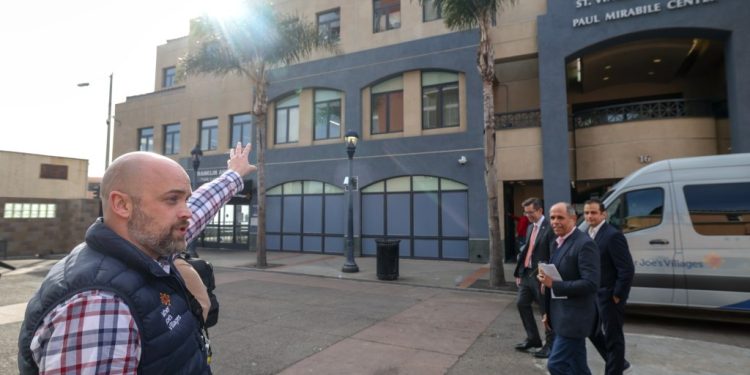The floor covering was torn. The wires are exposed. The screened concrete surrounds a glass wall which must still be removed.
The second level of the Paul Mirabile Center in downtown San Diego is in the last months of a renovation that will transform the long-standing homeless refuge into a space of detoxification and sober living. “We are trying to fill the cracks,” said Mary Jo Scarpitti, director of the Father Joe villages clinic. “You just need a little crack for someone to fall.”
Its declaration works literally and figuratively, because the organizations of homelessness in the region are increasingly investing in the treatment of drug addiction.
An Escondido municipal committee recently gave the initial approval of interconfessional community services in order to increase its total detoxification bed from 10 to 32 years. The County of San Diego moved more than a year ago to find accommodation for around 100 homeless people who were already in treatment and the state legislature examines again if taxpayers’ dollars can be used to finance Beds that force residents to abstain from alcohol and drugs.
The latter would be an important change for California. Current rules generally indicate that the facilities funded by cities or the state must be “low barrier”, which means that people can get a place even if they have trouble with drug addiction, although consumption of ‘Alcohol and drug use can be prohibited on site.
“This is obvious,” said Assembly member Matt Haney, a Democrat from San Francisco. Having people who want to sleep clean near those who “are like forcing someone who tries to get out of alcohol to live in a bar”.
Last year, Haney presented a bill that would relax the policy of the first housing policy in California to allow funding to get around the programs requiring sobriety. The proposal received bipartisan support overwhelming in the lower chamber of the legislative assembly – 72 members of the Assembly voted “yes” while none was opposed – but it blocked the State Senate.
After more negotiations to clarify how sober life programs would be verified, Haney recently reintroduced the AB-255 measure. The bill puts a ceiling on the number of these beds could receive public funds and it is optimistic that the modified language (combined with a slightly larger republican caucus in the Senate) will obtain the plan on the finish line.
Consecrate more resources to drug addiction seems to be an area of agreement between many Democrats and Republicans, as well as a possible source of compromise between Blue California and President Donald Trump, who has long wanted to revise the first housing policies at the level federal.
A large number of research has shown that prioritization of housing before other problems is effective in ending roaming. A massive Canadian study revealed that the first housing initiatives are more successful than efforts requiring treatment in advance – but the simple fact that the approach works for a large majority does not mean that it is perfect for everyone .
Father Joe’s staff said they interviewed the residents of the Paul Mirabile Center, when it was a low barrier refuge to ask what changes they would like to see. More than 70% asked for a space where everyone inside had sworn with drugs and alcohol.
Part of the resulting overhaul is already over. The non -profit program to reach independence and empowerment, or RISE, began at the start of the year on the third floor of the center. The renovation of the building required $ 1.5 million while annual operating costs will be around $ 3.6 million, a spokesperson said.
Private donors have taken the invoice.
During a tour last month, Robert Boudreau, 55, told journalists that dependence had been a major reason for which he had ended up living outside, and he welcomed both security and structure offered by RISE. “I’m not happy in the streets,” he said. “Regarding health, I knew I couldn’t do it any longer.”

Residents can bring pets and stay up to a year. You do not need a drug addiction disorder to obtain one of the 250 beds, but participants must accept drug screening tests and meetings with case workers. The male team is already full and around 90 people appeared on the waiting list in the middle of the week, according to a spokesperson. The non -profit organization continues to fill the women’s area.
Dozens of beds, however, are kept available for those who end up registering for the shooting program of 14 days on the ground below, which, hope, will be launched in April. Father Joe’s always hires staff, obtaining a state execution permit and building nearly a dozen rooms that will be able to contain more than 40 people.
The leaders have no illusions that two weeks are long enough to fully cure someone. But supporters hope that time will get vulnerable patients on more stable ground.

Scarpitti, the director of the clinic, knows the process well. Years ago, Scarpitti exchanged his hometown in New Jersey for a San Diego treatment program in the hope of kicking opioid dependence. The first weeks were marked by pain, shame and inability to sleep, she said. Scarpitti believes that the program may have put too much responsibility for it too quickly and hopes that Father Joe will rather give participants more, although with strict rules.
In the county of North, the Escondido planning commission voted last month to extend the interfaith detoxification program at the group’s city center. The proposal should be considered on February 19 by the full municipal council.
Originally published:
California Daily Newspapers


